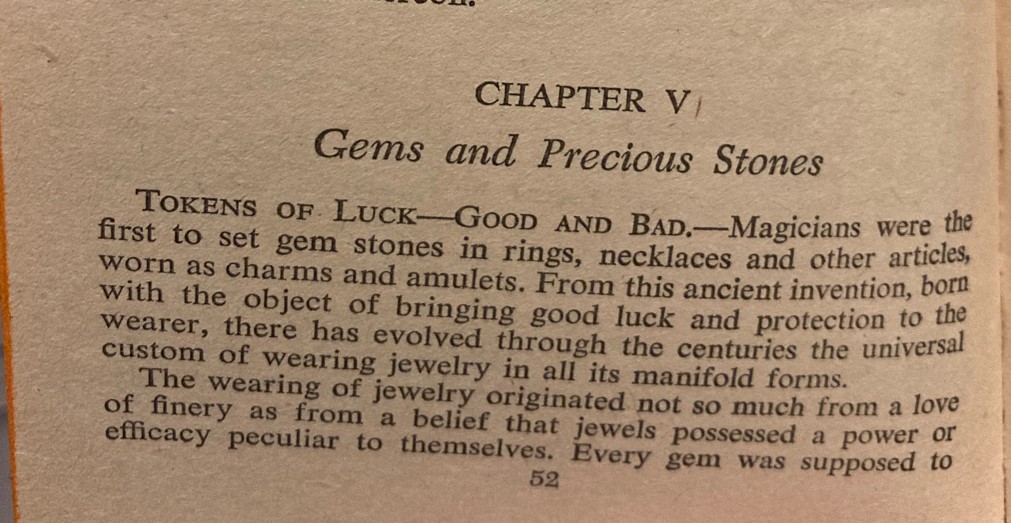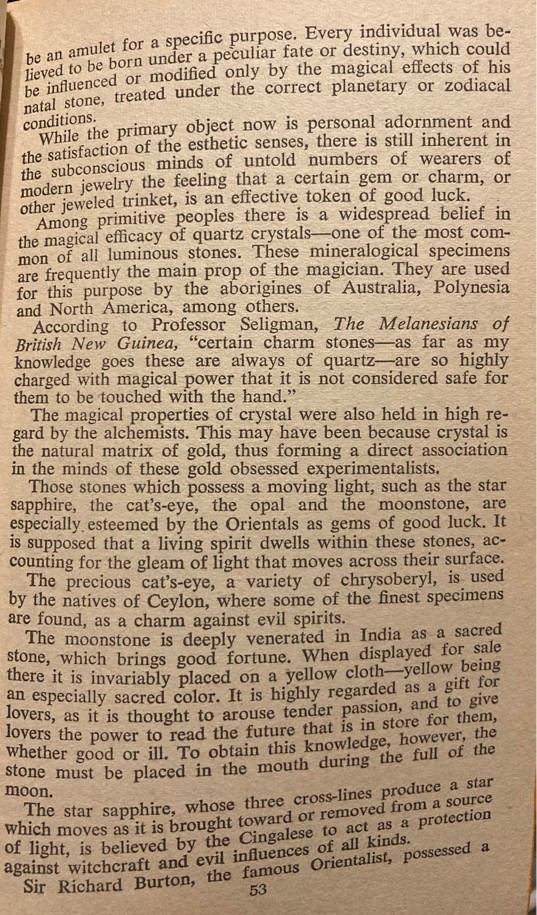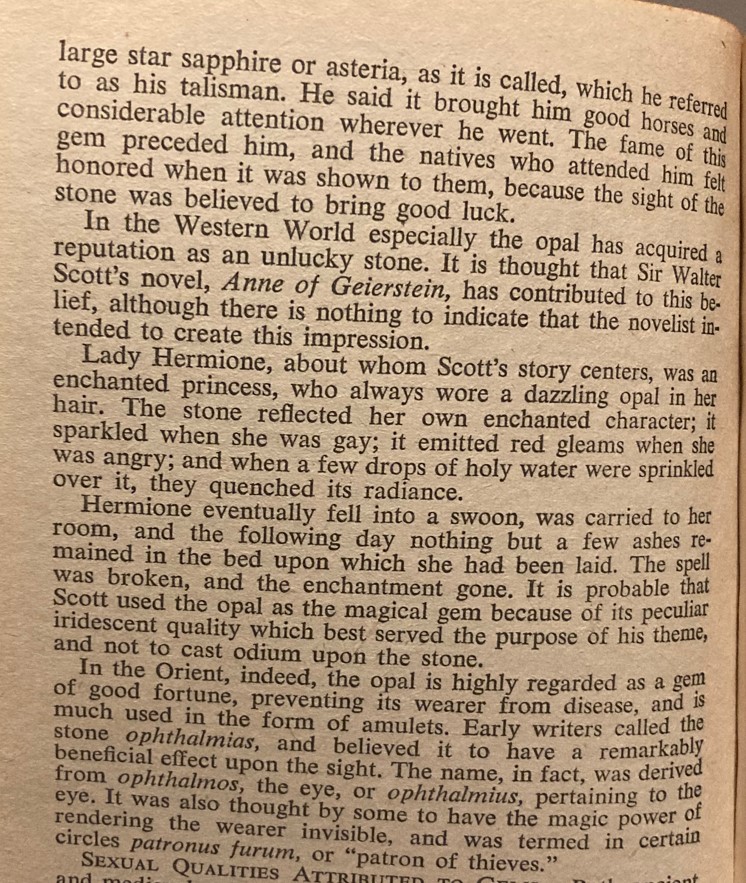William J. Fielding discusses the practice of crystal gazing.
- Type
- Book
- Source
- William J. Fielding Non-LDS
- Hearsay
- Secondary
- Reference
William J. Fielding, Strange Superstitions and Magical Practices (New York: Paperback Library, Inc., 1966), 52-54
- Scribe/Publisher
- Paperback LIbrary, Inc.
- People
- William J. Fielding
- Audience
- Reading Public
- Transcription
Gems and Precious Stones
TOKENS OF LUCK.—GOOD AND BAD.—Magicians were the first to set gem stones in rings, necklaces and other articles, worn as charms and amulets. From this ancient invention, born with the object of bringing good luck and protection to the wearer, there has evolved through the centuries the universal custom of wearing jewelry in all its manifold forms.
The wearing of jewlery originated not so much from a love of finery as from a belief that jewels possessed a power or efficacy peculiar to themselves. Every gem was supposed to be an amulet for a specific purpose. Every individual was believed to be born under a peculiar fate or destiny, which could be influenced or modified only by the magical effects of his natal stone, treated under the correct planetary or zodiacal conditions.
While the primary object now is personal adornment and the satisfaction of the esthetic senses, there is still inherent in the subconscious minds of untold numbers of wearers of modern jewelry the feeling that a certain gem or charm, or other jeweled trinket, is an effective token of good luck.
Among primitive peoples there is a widespread belief in the magical efficacy of quarts crystals—one of the most common of all luminous stones. These mineralogical specimens are frequently the main prop of the magician. They are used fo this purpose by the aborigines of Australia, Polynesia and North America, among others.
According to Professor Seligman, The Melanesians of British New Guinea, “certain charm stones—as far as my knowledge goes these are always of quartz—are so highly charged with magical power that it is not considered safe for them to be touched with the hand.”
The magical properties of crystal were also held in high regard by the alchemists. This may have been because crystal is the natural matrix of gold, thus forming a direct association in the minds of these gold obsessed experimentalists.
Those stones which possess a moving light, such as the star sapphire, the cat’s-eye, the opal and the moonstone, are especially esteemed by the Orientals as gems of good luck. It is supposed that a living spirit dwells within these stones, accounting for the gleam of light that moves across their surface.
The precious cat’s-eye, a variety of chrysoberyl, is used by the natives of Ceylon, where some of the finest specimens are found, as a charm against evil spirits.
The moonstone is deeply venerated in India as a sacred stone, which brings good fortune. When displayed for sale there it is invariably placed on a yellow cloth—yellow being an especially sacred color. It is highly regarded as a gift for lovers, as it is thought to arouse tender passion, and to give lovers the power to read the future that is in store for them, whether good or ill. To obtain this knowledge, however, the stone must be placed in the mouth during the full of the moon.
The star sapphire, whose cross-lines produce a star which moves as it is brought toward or removed from a source of light, is believed by the Cingalese to act as a protection against witchcraft and evil influences of all kinds.
Sir Richard Burton, the famous Orientalist, possessed a large star sapphire or asteria, as it is called, which he referred to as his talisman. He said it brought him good horses and considerable attention wherever he went. The fame of this gem proeceded him, and the natives who attended him felt honored when it was shown to them, because the sight of the stone was believed to bring good luck.
In the Western World especially the opal has acquired a reputation as an unlucky stone. It is thought that sir Walter Scott’s novel, Anne of Geierstein, has contributed to this belief, although there is nothing to indicate that the novelist intended to create this impression.
Lady Hermione, about whom Scott’s story centers, was an enchanted princess, who always wore a dazzling opal in her hair. The stone reflected her own enchanted character; it sparkled when she was gay; it emitted red gleams when she was angry, and when a few drops of holy water were sprinkled over it, they quenched its radiance.
Hermione eventually fell into a swoon, was carried to her room, and the following day nothing but a few ashes remained in the bed upon which she had been laid. The spell was broken, and the enchantment gone. It is probable that Scott used the opal as the magical gem because of its peculiar iridescent quality which best served the purpose of his theme, and not to cast odium upon the stone.
In the Orient, indeed, the opal is highly regarded as a gem of good fortune, preventing its wearer from disease, and is much used in the form of amulets. Early writers called the stone ophthalmias, and believed it to have a remarkably beneficial effect upon the sight. The same, in fact, was derived from ophthalmos, the eye, or ophthalmius, pertaining to the eye. It was also thought by some to have the magic power of rendering the wearer invisible, and was termed in certain circles patronus furum, or “patron of thieves.”
- Citations in Mormonr Qnas
The B. H. Roberts Foundation is not owned by, operated by, or affiliated with the Church of Jesus Christ of Latter-day Saints.



